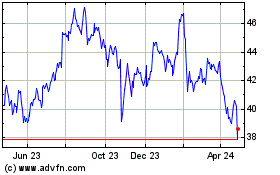Comcast Reaches 10G Technical Milestone Delivering 1.25 Gig Symmetrical Speeds in Trial Over a Live, All-Digital HFC Network
October 08 2020 - 2:00PM
Business Wire
Trial shows future path to delivering
multi-gigabit symmetrical speeds using Network Function
Virtualization technology in a hybrid fiber-coaxial (HFC)
network
Comcast today announced that it has achieved a 10G technical
milestone in a trial delivering 1.25 gigabit-per-second (Gbps)
upload and download speeds over a live production network using
Network Function Virtualization (NFV) combined with the latest
DOCSIS Technology.
This press release features multimedia. View
the full release here:
https://www.businesswire.com/news/home/20201008005824/en/
The trial also represents an important
milestone on the path to deliver on the promise of the industry’s
10G platform, which aims to enable 10-gigabits-per-second speeds
and beyond. (Graphic: Business Wire)
At a home in Jacksonville, Florida, technicians have installed
the service which is based upon a Distributed Access Architecture
(DAA) that Comcast has deployed throughout the area. This advanced
architecture includes a suite of software-powered networking
technologies, including digital fiber optics, “Remote PHY” digital
nodes, and a cloud-based, virtualized cable modem termination
system platform (vCMTS), enabling delivery of gigabit-plus
symmetrical speeds using existing cable connections. The technology
team consistently measured speeds of 1.25 Gbps upload and 1.25 Gbps
download over the connection.
“Our customers build their digital lives on the foundation of
our Internet service, so we continue to push the technological
envelope to anticipate their future needs,” said Tony Werner,
President of Technology, Product, Xperience at Comcast Cable. “The
great strength of our network technology is that we will have the
ability to scale these next-generation speeds to tens of millions
of homes in the future without digging up yards, or starting
massive construction projects. This technology provides a path to
meeting the needs of the future and making multi-gigabit
symmetrical speeds a reality for everyone, not just a select
few.”
Comcast has been an industry leader in deploying and evolving
network virtualization and DAA, which replaces physical elements of
traditional networks with software- and cloud-based technologies
that provide greater performance, increased reliability and the
ability to upgrade more quickly and evolve networks without
replacing physical equipment. This technology will be key to making
multi-gigabit symmetrical speeds widely available as part of
Comcast’s future, next-generation offerings.
In 2015, Comcast was the first ISP to deliver gigabit-class
service using DOCSIS 3.1 technology, and in 2018, the company
became the nation’s largest provider of gigabit speeds using that
technology.
The trial also represents an important milestone on the path to
deliver on the promise of the industry’s 10G platform, which aims
to eventually enable 10-gigabit-per-second speeds and beyond by
leveraging continuing advances in DOCSIS and other key network
technologies. Comcast is engaged in the 10G initiative along with
NCTA, CableLabs and SCTE, as well as operators from around the
world. In addition, Comcast and Charter Communications have worked
closely to align on their approaches to 10G and are driving
technology standards and architectures to benefit the industry. The
latest advancements in 10G technology will be on full display next
week at SCTE EXPO.
“We’re excited to move these incredible 10G technologies from
the laboratory to the living room,” said Elad Nafshi, Senior Vice
President of Next-Generation Access Technologies at Comcast Cable.
“We’ve been inspired by the work our global technical community has
done to advance the technologies that made this performance
possible and are proud to begin the process of delivering those
benefits to customers.”
The trial was made possible not by a single technological
innovation, but rather by a series of interrelated technologies
that Comcast continues to test and deploy in its network, all
powered by a DAA ecosystem. These include our increasingly
virtualized, cloud-based network model, a vCMTS; modern “Remote
PHY” optical nodes that provide greater speed and flexibility; and
the ongoing effort to extend fiber further into neighborhoods.
In the coming weeks, Comcast will expand the trial to more homes
as we continue to test the performance of the service under
multiple different home and network environments.
About Comcast
Comcast Corporation (Nasdaq: CMCSA) is a global media and
technology company with three primary businesses: Comcast Cable,
NBCUniversal, and Sky. Comcast Cable is one of the United States’
largest video, high-speed internet, and phone providers to
residential customers under the Xfinity brand, and also provides
these services to businesses. It also provides wireless and
security and automation services to residential customers under the
Xfinity brand. NBCUniversal is global and operates news,
entertainment and sports cable networks, the NBC and Telemundo
broadcast networks, television production operations, television
station groups, Universal Pictures, and Universal Parks and
Resorts. Sky is one of Europe's leading media and entertainment
companies, connecting customers to a broad range of video content
through its pay television services. It also provides
communications services, including residential high-speed internet,
phone, and wireless services. Sky operates the Sky News broadcast
network and sports and entertainment networks, produces original
content, and has exclusive content rights. Visit
www.comcastcorporation.com for more information.
View source
version on businesswire.com: https://www.businesswire.com/news/home/20201008005824/en/
Media Contact: David McGuire,
Comcast 215-422-2732 david_mcguire@comcast.com
Comcast (NASDAQ:CMCSA)
Historical Stock Chart
From Mar 2024 to Apr 2024

Comcast (NASDAQ:CMCSA)
Historical Stock Chart
From Apr 2023 to Apr 2024
